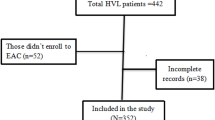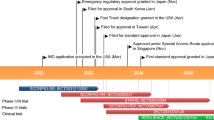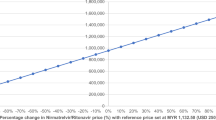Abstract
Nevirapine and efavirenz are nonnucleoside reverse transcriptase inhibitors used in antiretroviral regimens to treat HIV infection. Therapeutic drug monitoring in patients on antiretroviral regimens that include these agents has been suggested to be beneficial in terms of efficacy and toxicity. Various analytical methods are available to quantify nevirapine and efavirenz concentrations. A previously published, nine-step, decision-making algorithm has been used to evaluate the utility of therapeutic drug monitoring of efavirenz and nevirapine. A relationship has been found between efavirenz concentrations and toxicity and between nevirapine concentrations and virological efficacy. For efavirenz, the recommended therapeutic range is 1–4 mg/L; for nevirapine, minimum trough concentrations of >3.4 mg/L have been suggested. Both drugs have demonstrated interindividual pharmacokinetic variability. The pharmacokinetic parameters of nevirapine vary in female patients, patients coinfected with hepatitis B virus, and patients from different geographical locations. The pharmacokinetic parameters of efavirenz have also been shown to vary depending on patients’ race, baseline bilirubin level, and geographical location. Drug interactions and resistance mutations can also be confounders in the pharmacokinetic parameters of these drugs. Coinfection with hepatitis C can also contribute to increased drug concentrations. The risk of hepatotoxicity can be increased in the presence of elevated nevirapine concentrations. As patients with HIV-1 infection will be managed with different combinations of antiretroviral regimens over the course of their lives, the limitations of having only four drug classes from which to choose make it even more important to maximise the usefulness of each of these drug classes. The available evidence suggests that therapeutic drug monitoring of efavirenz and nevirapine may contribute to the clinician’s ability to evaluate efficacy and safety in patients taking these drugs. Patients at risk of toxicity from drug interactions or disease interactions and patients who may be noncompliant may gain the greatest benefit from therapeutic drug monitoring of efavirenz and nevirapine.




Similar content being viewed by others
References
UNAIDS/WHO. UNAIDS/WHO AIDS epidemic update: December 2005 [online]. Geneva: UNAIDS, 2005. Available from URL: [Accessed 2006 Dec 27]
Jordan R, Gold L, Cummins C, et al. Systematic review and meta-analysis of evidence for increasing numbers of drugs in antiretroviral combination therapy. BMJ 2002 Mar 30; 324(7340): 757–60
Smith PF, DiCenzo R, Morse GD. Clinical pharmacokinetics of non-nucleoside reverse transcriptase inhibitors. Clin Pharmacokinet 2001; 40(12): 893–905
US Department of Health and Human Services Panel on Antiretroviral Guidelines for Adults and Adolescents. Guidelines for the use of antiretroviral agents in HIV-1 infected adults and adolescents [online]. Rockville (MD): US Department of Health and Human Services, 2006. Available from URL: http://www.aidsinfo.nih.gov/Guidelines/GuidelineDetail.aspx?MenuItem=Guidelines&Search=Off&GuidelineID=7&ClassID=1 [Accessed 2007 Jan 10]
Ensom MHH, Davis GA, Cropp CD, et al. Clinical pharmacokinetics in the 21st century: does the evidence support definitive outcomes? Clin Pharmacokinet 1998; 34(4): 265–79
Staszewski S, Morales-Ramirez J, Tashima KT, et al. Efavirenz plus zidovudine and lamivudine, efavirenz plus indinavir, and indinavir plus zidovudine and lamivudine in the treatment of HIV-1 infection in adults. N Engl J Med 1999 Dec 16; 341(25): 1865–73
Robbins GK, De Gruttola V, Shafer RW, et al. Comparison of sequential three-drug regimens as initial therapy for HIV-1 infection. N Engl J Med 2003 Dec 11; 349(24): 2293–303
Gulick RM, Ribaudo HJ, Shikuma CM, et al. Triple-nucleoside regimens versus efavirenz-containing regimens for the initial treatment of HIV-1 infection. N Engl J Med 2004 Apr 29; 350(18): 1850–61
Van Leth F, Phanuphak P, Ruxrungtham K, et al. Comparison of first-line antiretroviral therapy with regimens including nevirapine, efavirenz, or both drugs, plus stavudine and lamivudine: a randomised open-label trial, the 2NN Study. Lancet 2004 Apr 17; 363(9417): 1253–63
Poirier JM, Robidou P, Jaillon P. Simple and simultaneous determination of the HIV-protease inhibitors amprenavir, atazanavir, indinavir, lopinavir, nelfinavir, ritonavir and saquinavir plus M8 nelfinavir metabolite and the nonnucleoside reverse transcriptase inhibitors efavirenz and nevirapine in human plasma by reversed-phase liquid chromatography. Ther Drug Monit 2005; 27(2): 186–92
Kappelhoff BS, Rosing H, Huitema ADR, et al. Simple and rapid method for the simultaneous determination of the non-nucleoside reverse transcriptase inhibitors efavirenz and nevirapine in human plasma using liquid chromatography. J Chromatogr B Analyt Technol Biomed Life Sci 2003 Jul 25; 792(2): 353–62
Langmann P, Schirmer D, Vath T, et al. High-performance liquid chromatographic method for the determination of HIV-1 non-nucleoside reverse transcriptase inhibitor efavirenz in plasma of patients during highly active antiretroviral therapy. J Chromatogr B Biomed Sci Appl 2001; 755(1–2): 151–6
Koal T, Burhenne H, Romling R, et al. Quantification of antiretroviral drugs in dried blood spot samples by means of liquid chromatography/tandem mass spectrometry. Rapid Commun Mass Spectrom 2005; 19(21): 2995–3001
Hirabayashi Y, Tsuchiya K, Kimura S, et al. Simultaneous determination of six HIV protease inhibitors (amprenavir, indinavir, lopinavir, nelfinavir, ritonavir and saquinavir), the active metabolite of nelfinavir (M8) and non-nucleoside reverse transcriptase inhibitor (efavirenz) in human plasma by high-performance liquid chromatography. Biomed Chromatogr 2006 Jan; 20(1): 28–36
Gutierrez F, Navarro A, Padilla S, et al. Prediction of neuropsychiatric adverse events associated with long-term efavirenz therapy, using plasma drug level monitoring. Clin Infect Dis 2005 Dec 1; 41(11): 1648–53
Lemmer P, Schneider S, Schuman M, et al. Determination of nevirapine and efavirenz in plasma using GC/MS in selected ion monitoring mode. Ther Drug Monit 2005; 27(4): 521–5
Aymard G, Legrand M, Trichereau N, et al. Determination of twelve antiretroviral agents in human plasma sample using reversed-phase high-performance liquid chromatography. J Chromatogr B Biomed Sci Appl 2000 Jul 21; 744(2): 227–40
Aarnoutse RE, Grintjes KJT, Telgt DSC, et al. The influence of efavirenz on the pharmacokinetics of a twice-daily combination of indinavir and low-dose ritonavir in healthy volunteers. Clin Pharmacol Ther 2002; 71(1): 57–67
Colombo S, Beguin A, Telenti A, et al. Intracellular measurements of anti-HIV drugs indinavir, amprenavir, saquinavir, ritonavir, nelfinavir, lopinavir, atazanavir, efavirenz and nevirapine in peripheral blood mononuclear cells by liquid chromatography coupled to tandem mass spectrometry. J Chromatogr B Anal Technol Biomed Life Sci 2005 May 25; 819(2): 259–76
Dailly E, Thomas L, Kergueris MF, et al. High-performance liquid chromatographic assay to determine the plasma levels of HIV-protease inhibitors (amprenavir, indinavir, nelfinavir, ritonavir and saquinavir) and the non-nucleoside reverse transcriptase inhibitor (nevirapine) after liquid-liquid extraction. J Chromatogr B Biomed Sci Appl 2001 Jul 15; 758(2): 129–35
Marzolini C, Telenti A, Buclin T, et al. Simultaneous determination of the HIV protease inhibitors indinavir, amprenavir, saquinavir, ritonavir, nelfinavir and the non-nucleoside reverse transcriptase inhibitor efavirenz by high-performance liquid chromatography after solid-phase extraction. J Chromatogr B Biomed Sci Appl 2000 Mar 31; 740(1): 43–58
Pav JW, Rowland LS, Korpalski DJ. HPLC-UV method for the quantitation of nevirapine in biological matrices following solid phase extraction. J Pharm Biomed Anal 1999; 20(1–2): 91–8
Pelerin H, Compain S, Duval X, et al. Development of an assay method for the detection and quantification of protease and non-nucleoside reverse transcriptase inhibitors in plasma and in peripheral blood mononuclear cells by liquid chromatography coupled with ultraviolet or tandem mass spectrometry detection. J Chromatogr B Anal Technol Biomed Life Sci 2005 May 5; 819(1): 47–57
Stahle L, Moberg L, Svensson J, et al. Efavirenz plasma concentrations in HIV-infected patients: inter- and intraindividual variability and clinical effects. Ther Drug Monit 2004; 26(3): 267–70
Takahashi M, Yoshida M, Oki T, et al. Conventional HPLC method used for simultaneous determination of the seven HIV protease inhibitors and nonnucleoside reverse transcription inhibitor efavirenz in human plasma. Biol Pharm Bull 2005; 28(7): 1286–90
Titier K, Lagrange F, Pehourcq F, et al. High-performance liquid chromatographic method for the simultaneous determination of the six HIV-protease inhibitors and two non-nucleoside reverse transcriptase inhibitors in human plasma. Ther Drug Monit 2002 Jun; 24(3): 417–24
Van Heeswijk RPG, Hoetelmans RMW, Meenhorst PL, et al. Rapid determination of nevirapine in human plasma by ion-pair reversed-phase high-performance liquid chromatography with ultraviolet detection. J Chromatogr B Biomed Appl 1998; 713(2): 395–9
Veldkamp AI, Van Heeswijk RPG, Meenhorst PL, et al. Quantitative determination of efavirenz (DMP 266), a novel non-nucleoside reverse transcriptase inhibitor, in human plasma using isocratic reversed-phase high-performance liquid chromatography with ultraviolet detection. J Chromatogr B Biomed Sci Appl 1999; 734(1): 55–61
Azoulay S, Nevers MC, Creminon C, et al. Sensitive enzyme immunoassay for measuring plasma and intracellular nevirapine levels in human immunodeficiency virus-infected patients. Antimicrob Agents Chemother 2004; 48(1): 104–9
Armstrong VW, Oellerich M. Critical evaluation of methods for therapeutic drug monitoring. In: Burton ME, Schentag JJ, Shaw LM, et al., editors. Applied pharmacokinetics and pharmacodynamics. 4th ed. Baltimore (MD): Lippincott Williams and Wilkins, 2006: 30–7
Langmann P, Weissbrich B, Desch S, et al. Efavirenz plasma levels for the prediction of treatment failure in heavily pretreated HIV-1 infected patients. Eur J Med Res 2002 Jul 24; 7(7): 309–14
Veldkamp AI, Weverling GJ, Lange JMA, et al. High exposure to nevirapine in plasma is associated with an improved virological response in HIV-1 infected individuals. AIDS 2001; 15: 1089–95
Gonzales de Requena D, Bonora S, Garazzino S, et al. Nevirapine plasma exposure affects both durability of viral suppression and selection of nevirapine primary resistance mutations in a clinical setting. Antimicrob Agents Chemother 2005; 49(9): 3966–9
de Vries Sluijs TE, Dieleman JP, Arts D, et al. Low nevirapine plasma concentrations predict virological failure in an un-selected HIV-1-infected population. Clin Pharmacokinet 2003; 42(6): 599–605
Duong M, Buisson M, Peytavin G, et al. Low trough plasma concentrations of nevirapine associated with virologic rebounds in HIV infected patients who switched from protease inhibitors. Ann Pharmacother 2005; 39(4): 603–9
Kappelhoff BS, van Leth F, Robinson PA, et al. Are adverse events of nevirapine and efavirenz related to plasma concentrations? Antivir Ther 2005; 10(4): 489–98
Gallego L, Barreiro P, Del Rio R, et al. Analyzing sleep abnormalities in HIV-infected patients treated with efavirenz. Clin Infect Dis 2004 Feb 1; 38(3): 430–2
Fumaz CR, Muñoz-Moreno JA, Molto J, et al. Long-term neuropsychiatric disorders on efavirenz-based approaches: quality of life, psychologic issues, and adherence. J Acquir Immune Defic Syndr 2005 Apr 15; 38(5): 560–5
Lochet P, Peyriere H, Lotthe A, et al. Long-term assessment of neuropsychiatric adverse reactions associated with efavirenz. HIV Med 2003; 4(1): 62–6
Robertson SM, Scarsi KK, Postelnick MJ, et al. Elevated plasma concentrations of protease inhibitors and nonnucleoside reverse transcriptase inhibitors in patients coinfected with human immunodeficiency virus and hepatitis B or C: case series and literature review. Pharmacotherapy 2005 Aug; 25(8): 1068–72
Nunez M, Gonzalez-Requena D, Gonzalez-Lahoz J, et al. Short communication: interactions between nevirapine plasma levels, chronic hepatitis C, and the development of liver toxicity in HIV-infected patients. AIDS Res Hum Retroviruses 2003 Mar; 19(3): 187–8
Gonzalez de Requena D, Nuñez M, Jimenez-Nacher I, et al. Liver toxicity caused by nevirapine [letter]. AIDS 2002 Jan 25; 16(2): 290–1
Dailly E, Billaud E, Reliquet V, et al. No relationship between high nevirapine plasma concentration and hepatotoxicity in HIV-1-infected patients naive of antiretroviral treatment or switched from protease inhibitors. Eur J Clin Pharmacol 2004; 60(5): 343–8
De Requena DG, Jimenez-Nacher I, Soriano V. Changes in nevirapine plasma concentrations over time and its relationship with liver enzyme elevations. AIDS Res Hum Retroviruses 2005; 21(6): 555–9
Bickel M, Stephan C, Rottmann C, et al. Severe CNS side-effect and persistent high efavirenz plasma levels in a patient with HIV/HCV coinfection and liver cirrhosis. Scand J Infect Dis 2005; 37(6–7): 520–2
Maserati R, Villani P, Seminari E, et al. High plasma levels of nelfinavir and efavirenz in two HIV-positive patients with hepatic disease [letter]. AIDS 1999; 13(7): 870–1
Veldkamp AI, Weverling GJ, Lange JMA, et al. High exposure to nevirapine in plasma is associated with an improved virological response in HIV-1-infected individuals. AIDS 2001 Jun 15; 15(9): 1089–95
Virology Education BV. HIVPharmacology.com: drugs. Drug PK profiles: nevirapine [online]. Available from URL: http://hivpharmacology.com [Accessed 2007 Jan 10]
Virology Education BV. HIVPharmacology.com: drugs. Drug PK profiles: efavirenz [online]. Available from URL: http://hivpharmacology.com [Accessed 2007 Jan 10]
de Requena DG, Bonora S, Garazzino S, et al. Nevirapine plasma exposure affects both durability of viral suppression and selection of nevirapine primary resistance mutations in a clinical setting. Antimicrob Agents Chemother 2005; 49(9): 3966–9
Marzolini C, Telenti A, Decosterd LA, et al. Efavirenz plasma levels can predict treatment failure and central nervous system side effects in HIV-1-infected patients. AIDS 2001 Jan 5; 15(1): 71–5
Csajka C, Marzolini C, Fattinger K, et al. Population pharmacokinetics and effects of efavirenz in patients with human immunodeficiency virus infection. Clin Pharmacol Ther 2003 Jan 1; 73(1): 20–30
Kappelhoff BS, van Leth F, MacGregor TR, et al. Nevirapine and efavirenz pharmacokinetics and covariate analysis in the 2NN study. Antivir Ther 2005; 10(1): 145–55
Kappelhoff BS, Huitema ADR, Yalvac Z, et al. Population pharmacokinetics of efavirenz in an unselected cohort of HIV-1-infected individuals. Clin Pharmacokinet 2005; 44(8): 849–61
Rainey PM. HIV drug interactions: the good, the bad, and the other. Ther Drug Monit 2002; 24(1): 26–31
Haas DW. Will pharmacogenomic discoveries improve HIV therapeutics? Top HIV Med 2005 Aug–Sep; 13(3): 90–5
Rotger M, Colombo S, Furrer H, et al. Influence of CYP2B6 polymorphism on plasma and intracellular concentrations and toxicity of efavirenz and nevirapine in HIV-infected patients. Pharmacogenet Genomics 2005 Jan; 15(1): 1–5
Brennan-Benson P, Lyus R, Harrison T, et al. Pharmacokinetic interactions between efavirenz and rifampicin in the treatment of HIV and tuberculosis; one size does not fit all. AIDS 2005 Sep 23; 19(14): 1541–3
Robertson SM, Penzak SR, Lane J, et al. A potentially significant interaction between efavirenz and phenytoin: a case report and review of the literature. Clin Infect Dis 2005; 41(2): E15–8
Ma Q, Okusanya OO, Smith PF, et al. Pharmacokinetic drug interactions with non-nucleoside reverse transcriptase inhibitors. Expert Opin Drug Metab Toxicol 2005; 1(3): 473–85
The Immunodeficiency Clinic, Toronto General Hospital-University Health Network. Drug interaction tables [online]. Available from URL: http://www.tthhivclinic.com/interact_tables.html [Accessed 2006 Dec 27]
Gonzalez De Requena D, Gallego O, Corral A, et al. Higher efavirenz concentrations determine the response to viruses carrying non-nucleoside reverse transcriptase resistance mutations. AIDS 2004 Oct 21; 18(15): 2091–4
Fellay J, Marzolini C, Meaden ER, et al. Response to antiretroviral treatment in HIV-1-infected individuals with allelic variants of the multidrug resistance transporter 1: a pharmacogenetics study. Lancet 2002 Jan 5; 359(9300): 30–6
Haas DW, Bartlett JA, Andersen JW, et al. Pharmacogenetics of nevirapine-associated hepatotoxicity: an Adult AIDS Clinical Trials Group collaboration. Clin Infect Dis 2006 Sep 15; 43(6): 783–6
Ritchie MD, Haas DW, Motsinger AA, et al. Drug transporter and metabolizing enzyme gene variants and nonnucleoside reverse-transcriptase inhibitor hepatotoxicity. Clin Infect Dis 2006 Sep 15; 43(6): 779–82
Ensom MH, Chang TK, Patel P. Pharmacogenetics: the therapeutic drug monitoring of the future? Clin Pharmacokinet 2001; 40(11): 783–802
Palella Jr FJ, Delaney KM, Moorman AC, et al. Declining morbidity and mortality among patients with advanced human immunodeficiency virus infection. N Engl J Med 1998 Mar 26; 338(13): 853–60
Rendon AL, Nuñez M, Jimenez-Nacher I, et al. Clinical benefit of interventions driven by therapeutic drug monitoring. HIV Med 2005; 6(5): 360–5
Crommentuyn KM, Huitema AD, Brinkman K, et al. Therapeutic drug monitoring of nevirapine reduces pharmacokinetic variability but does not affect toxicity or virologic success in the ATHENA study. J Acquir Immune Defic Syndr 2005 Jun 1; 39(2): 249–50
Mallon PW, Ray J, Cooper DA. Effect of therapeutic drug monitoring on outcome in antiretroviral experienced HIV-infected individuals. J Clin Virol 2003 Feb; 26(2): 223–7
Acknowledgements
No funding was provided to assist in the preparation of this review. The authors have no conflicts of interest that are directly relevant to the content of this review.
Author information
Authors and Affiliations
Corresponding author
Rights and permissions
About this article
Cite this article
Dahri, K., Ensom, M.H.H. Efavirenz and Nevirapine in HIV-1 Infection. Clin Pharmacokinet 46, 109–132 (2007). https://doi.org/10.2165/00003088-200746020-00002
Published:
Issue Date:
DOI: https://doi.org/10.2165/00003088-200746020-00002




